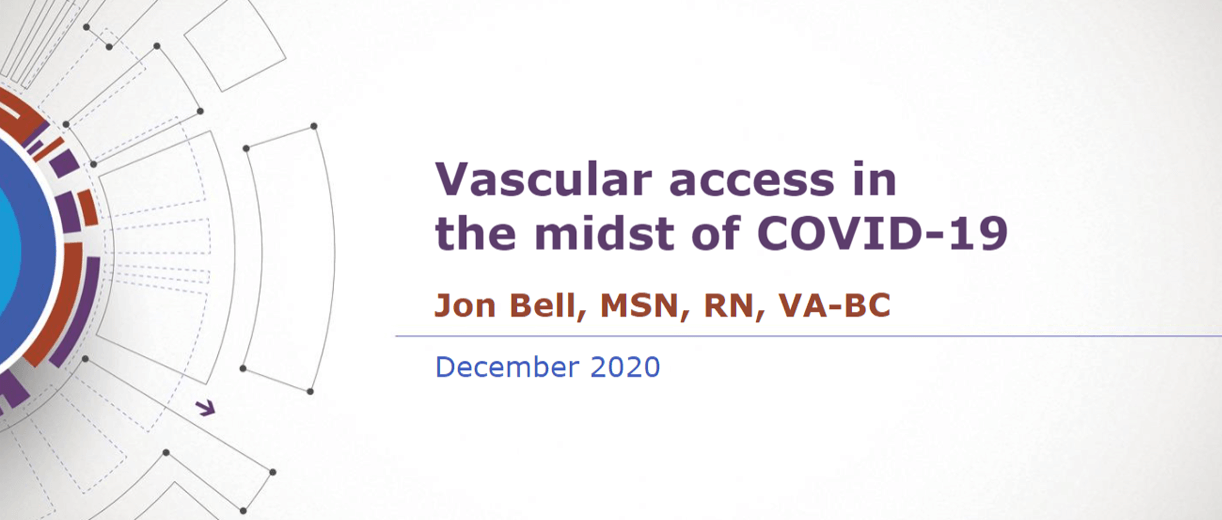Vascular access with COVID-19 webinar replay: a U.S perspective
The COVID-19 pandemic has brought many challenges to healthcare. Among them, overburdened healthcare systems have highlighted inefficiencies in vascular access (VA) processes.1 John Bell, a vascular access specialist and consultant based in the United States, is of the opinion that, historically, VA has not been treated very seriously, citing that up to 50% of peripheral intravenous (PIV) catheters fail.2
During the webinar, Bell discusses how COVID-19 provides a new challenge for VA and the importance of good VA practices in the placement and care and maintenance of both peripheral and central devices.
Impact of COVID-19 on vascular access
Operating under stressful conditions brought on by the pandemic has brought to light longstanding practice inefficiencies that many healthcare workers (HCWs) no longer notice. PIV failure is sometimes tolerated, but when working under stress and an overburdened healthcare system, it becomes more critical to do things right the first time.
More on this topic: Tripledemic may return to Europe this winter: Vaccination still key
Bell explores how COVID-19 has required us to reassess the impact that failed IV access can have:
- Increase in complications
- Increase in staff exposure
- Treatment delays
- Increase PIV sticks
- Patient discomfort
- Increase cost
- Increase in supply usage
- Clinician stress
The pandemic is demanding first-stick proficiency and up until now, according to Bell, this topic has not been addressed with the effort it merits.
A need for vascular access process improvements – not only in times of crisis
To make process improvements in general, Bell states that VA needs to be treated according to the scientific evidence available. Some VA communities do not grant the necessary empowerment for VA specialists to act in this capacity. Part of the issue also stems from a lack of HCW education and knowledge.
What can we do?
According to Bell, we must go back to the basic standards of practice and guidelines and give patients the VA that they need and deserve. He explains, “We need to improve vascular access assessment, we need to improve the insertion of peripheral, midline and central line, and we need to improve VA care and maintenance.”
Regarding COVID-19 patients, different treatment plans may need to be considered. They may need a more robust IV therapy choice due to longer hospital stays. Airway management needs to be considered in addition to the pronation of patients as this may impact the placement and stabilisation of IV lines.
Bell says that, due to COVID, identifying difficult IV access (DIVA) patients is going to be a special concern…We know from the research that objectively identified DIVA patients have many more IV sticks than non-DIVA patients …These are patients that will especially benefit from early identification and treatment which will save us time and resources,…it will reduce their treatment delays, improve their outcomes and reduce their infection risk. These DIVA patients can especially benefit from improvements we can bring to VA.
Assessment tools also enable objective assessment regardless of HCWs’ experience levels and empower staff to ask for assistance before making failed IV insertion attempts. They enhance first-stick success which helps with vessel health and preservation, a limited resource in patients, which is sometimes overlooked.
More on this topic: World Immunisation Week—vaccines and syringes then and now
Opportunities for the future
Bell concludes the webinar by paraphrasing a quote by Napoleon Hill, “there is opportunity to find great benefit even in times of adversity”. According to Bell, one of the great benefits derived from the pandemic is that that the stress of the situation has encouraged HCWs to recognize things that aren’t being done well. He believes it is the perfect moment for VA specialists to begin acting in their full scope of practice; to make strides toward more effective VA and, in turn, better patient care.
References
- Bell J. Vascular access in the midst of COVID-19. BD, December 2020. Webinar. https://event.webcasts.com/viewer/event.jsp?ei=1405904&tp_key=537062e27f
- Helm RE, Klausner JD, Klemperer JD, Flint LM, Huang E. Accepted but unacceptable: peripheral IV catheter failure. J Infus Nurs. 2015;38:189–203
This list of references to third-party peer-reviewed material and the sites they are hosted on are provided for your reference and convenience only, and do not imply any review or endorsement of the material or any association with their operators. The Third-Party References (and the Web sites to which they link) may contain information that is inaccurate, incomplete, or outdated. Your access and use of the Third Party Sites (and any Web sites to which they link) is solely at your own risk.
This presentation was developed by the presenter, and the findings, interpretations, and conclusions contained or expressed with it do not necessarily reflect the views of BD. To the extent this presentation relates to specific products, such products should always be used in accordance with the relevant instructions for use and other product documentation. This content should not be copied or distributed without the consent of the copyright holder. For further information, please contact: GMB-EU-MDS@bd.com
BD-33090




